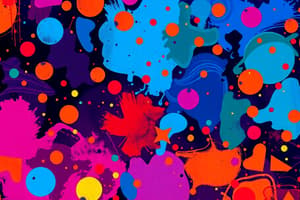Podcast
Questions and Answers
What is the primary focus of pharmacology?
What is the primary focus of pharmacology?
- The study of the interactions between nutrients and biological systems
- The study of the effects of drugs on living organisms (correct)
- The study of the interactions between hormones and biological systems
- The study of the effects of diseases on living organisms
What is the study of the interactions between drugs and biological systems?
What is the study of the interactions between drugs and biological systems?
- Toxicology
- Pharmacokinetics
- Pharmacodynamics
- Pharmacology (correct)
What is pharmacokinetics primarily concerned with?
What is pharmacokinetics primarily concerned with?
- The effects of drugs on the body
- The interactions between drugs and biological systems
- The absorption, distribution, metabolism, and excretion of drugs (correct)
- The mechanism of action of drugs
What is the process of drug uptake into the bloodstream called?
What is the process of drug uptake into the bloodstream called?
What is the study of the mechanisms of action of drugs called?
What is the study of the mechanisms of action of drugs called?
What is the relationship between drug dose and effect called?
What is the relationship between drug dose and effect called?
What is the term for the increased effect when two drugs are used together?
What is the term for the increased effect when two drugs are used together?
What is the term for the decreased effect when two drugs are used together?
What is the term for the decreased effect when two drugs are used together?
Flashcards are hidden until you start studying
Study Notes
Definition and Scope
- Pharmacology is the study of the effects of drugs on living organisms
- It involves the study of the interactions between drugs and biological systems
- Scope includes:
- Pharmacokinetics (absorption, distribution, metabolism, excretion)
- Pharmacodynamics (mechanisms of action, effects on the body)
- Toxicology (adverse effects, poisoning)
Types of Drugs
- Pharmacological classification:
- By mechanism of action (e.g., beta blockers, ACE inhibitors)
- By therapeutic use (e.g., antibiotics, analgesics)
- By chemical structure (e.g., beta lactams, sulfonamides)
- Drug categories:
- Over-the-counter (OTC) drugs: available without prescription
- Prescription drugs: require a prescription from a healthcare professional
- Recreational drugs: used for non-medical purposes (e.g., alcohol, nicotine)
Pharmacokinetics
- Absorption: process of drug uptake into the bloodstream
- Distribution: movement of drug from bloodstream to tissues
- Metabolism: breakdown of drug into inactive metabolites
- Excretion: elimination of drug from the body (e.g., kidney, liver)
Pharmacodynamics
- Mechanism of action: how a drug produces its effects
- Receptors: specific binding sites for drugs on cells
- Dose-response curve: relationship between drug dose and effect
- Therapeutic index: measure of a drug's safety and efficacy
Drug Interactions
- Pharmacokinetic interactions: alterations in absorption, distribution, metabolism, or excretion
- Pharmacodynamic interactions: alterations in drug effects
- Synergism: increased effect when two drugs are used together
- Antagonism: decreased effect when two drugs are used together
Definition and Scope
- Pharmacology is the study of the effects of drugs on living organisms
- It involves the study of the interactions between drugs and biological systems
- The scope of pharmacology includes pharmacokinetics, pharmacodynamics, and toxicology
Types of Drugs
- Drugs can be classified pharmacologically by mechanism of action, therapeutic use, or chemical structure
- Drug categories include over-the-counter (OTC) drugs, prescription drugs, and recreational drugs
- OTC drugs are available without prescription, while prescription drugs require a prescription from a healthcare professional
- Recreational drugs are used for non-medical purposes
Pharmacokinetics
- Absorption is the process of drug uptake into the bloodstream
- Distribution refers to the movement of drug from bloodstream to tissues
- Metabolism is the breakdown of drug into inactive metabolites
- Excretion is the elimination of drug from the body through kidney, liver, or other means
Pharmacodynamics
- Mechanism of action refers to how a drug produces its effects
- Receptors are specific binding sites for drugs on cells
- Dose-response curve shows the relationship between drug dose and effect
- Therapeutic index is a measure of a drug's safety and efficacy
Drug Interactions
- Pharmacokinetic interactions alter drug absorption, distribution, metabolism, or excretion
- Pharmacodynamic interactions alter drug effects
- Synergism is an increased effect when two drugs are used together
- Antagonism is a decreased effect when two drugs are used together
Studying That Suits You
Use AI to generate personalized quizzes and flashcards to suit your learning preferences.




